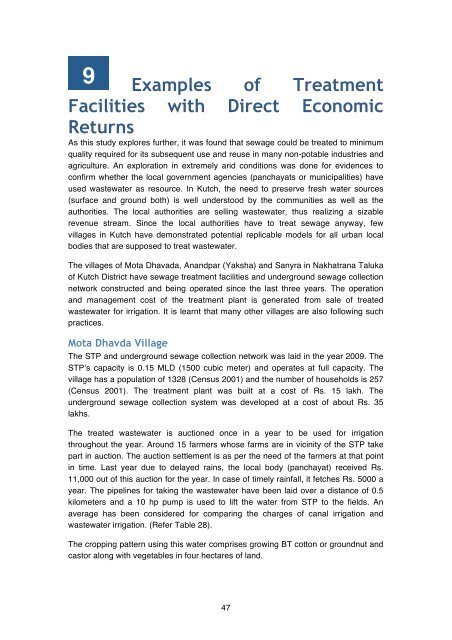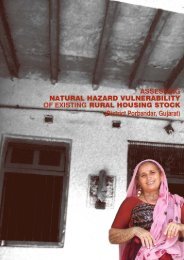Wastewater Irrigation in Gujarat - People in Centre Consulting
Wastewater Irrigation in Gujarat - People in Centre Consulting
Wastewater Irrigation in Gujarat - People in Centre Consulting
You also want an ePaper? Increase the reach of your titles
YUMPU automatically turns print PDFs into web optimized ePapers that Google loves.
9<br />
Examples of Treatment<br />
Facilities with Direct Economic<br />
Returns<br />
As this study explores further, it was found that sewage could be treated to m<strong>in</strong>imum<br />
quality required for its subsequent use and reuse <strong>in</strong> many non-potable <strong>in</strong>dustries and<br />
agriculture. An exploration <strong>in</strong> extremely arid conditions was done for evidences to<br />
confirm whether the local government agencies (panchayats or municipalities) have<br />
used wastewater as resource. In Kutch, the need to preserve fresh water sources<br />
(surface and ground both) is well understood by the communities as well as the<br />
authorities. The local authorities are sell<strong>in</strong>g wastewater, thus realiz<strong>in</strong>g a sizable<br />
revenue stream. S<strong>in</strong>ce the local authorities have to treat sewage anyway, few<br />
villages <strong>in</strong> Kutch have demonstrated potential replicable models for all urban local<br />
bodies that are supposed to treat wastewater.<br />
The villages of Mota Dhavada, Anandpar (Yaksha) and Sanyra <strong>in</strong> Nakhatrana Taluka<br />
of Kutch District have sewage treatment facilities and underground sewage collection<br />
network constructed and be<strong>in</strong>g operated s<strong>in</strong>ce the last three years. The operation<br />
and management cost of the treatment plant is generated from sale of treated<br />
wastewater for irrigation. It is learnt that many other villages are also follow<strong>in</strong>g such<br />
practices.<br />
Mota Dhavda Village<br />
The STP and underground sewage collection network was laid <strong>in</strong> the year 2009. The<br />
STP’s capacity is 0.15 MLD (1500 cubic meter) and operates at full capacity. The<br />
village has a population of 1328 (Census 2001) and the number of households is 257<br />
(Census 2001). The treatment plant was built at a cost of Rs. 15 lakh. The<br />
underground sewage collection system was developed at a cost of about Rs. 35<br />
lakhs.<br />
The treated wastewater is auctioned once <strong>in</strong> a year to be used for irrigation<br />
throughout the year. Around 15 farmers whose farms are <strong>in</strong> vic<strong>in</strong>ity of the STP take<br />
part <strong>in</strong> auction. The auction settlement is as per the need of the farmers at that po<strong>in</strong>t<br />
<strong>in</strong> time. Last year due to delayed ra<strong>in</strong>s, the local body (panchayat) received Rs.<br />
11,000 out of this auction for the year. In case of timely ra<strong>in</strong>fall, it fetches Rs. 5000 a<br />
year. The pipel<strong>in</strong>es for tak<strong>in</strong>g the wastewater have been laid over a distance of 0.5<br />
kilometers and a 10 hp pump is used to lift the water from STP to the fields. An<br />
average has been considered for compar<strong>in</strong>g the charges of canal irrigation and<br />
wastewater irrigation. (Refer Table 28).<br />
The cropp<strong>in</strong>g pattern us<strong>in</strong>g this water comprises grow<strong>in</strong>g BT cotton or groundnut and<br />
castor along with vegetables <strong>in</strong> four hectares of land.<br />
47




